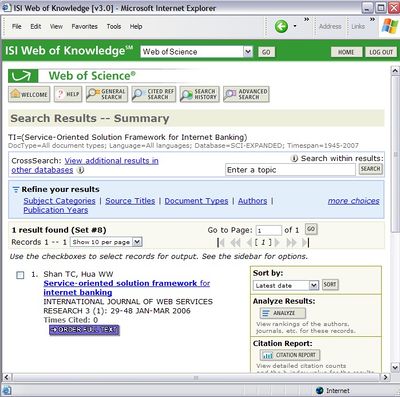شبكة المعرفة
ISI Web of Knowledge is an academic citation indexing and search service, which is combined with web linking and provided by Thomson Reuters. Web of Knowledge coverage encompasses the sciences, social sciences, arts and humanities. It provides bibliographic content and the tools to access, analyze, and manage research information. A notable attribute is that multiple databases can be searched simultaneously.[1][2]
Overview
It is described as a unifying research tool which enables the user to acquire, analyze, and disseminate database information in a timely manner. This is accomplished because of the creation of a common vocabulary for varied search terms and varied data. Moreover, search terms generate related information across categories.
Acceptable content for the Web of Knowledge is determined by an evaluation and selection process based on the following criteria: impact, influence, timeliness, peer review, and geographic representation.[1]
Search and analysis
Web of Knowledge employs various notable search and analysis capabilities. First, Citation indexing is employed, which is enhanced by the capability to search for results across disciplines. The influence, impact, history, and methodology of an idea can be followed from its first instance, notice, or referral to the present day. This technology points to a deficiency with the keyword-only method of searching. Second, subtle trends and patterns, relevant to the literature or research of interest become apparent. Broad trends indicate significant topics of the day, as well as the history relevant to both the work at hand, and particular areas of study. Third, trends can be graphically represented. [1][3]
The database
The database includes the following:
- 23,000 academic and science journals (Including Web of Science journal listings)
- 23,000,000 patents
- 110,000 proceedings
- 9,000 websites
- Coverage from the year 1900 to present day (with Web of Science)
- Over 40 million source items
- Integrated and simultaneous searching across multiple databases [1]
Abstracting and indexing
The ISI Web of Knowledge suite encompasses the following databases: [4][5]
- Arts & Humanities Citation Index is accessed via the Web of Science
- Biological Abstracts
- Biosis Citation Index on the ISI Web of Knowledge platform
- CAB Abstracts from CAB Direct
- Conference Proceedings Citation Index complements and extends the journal-based information in other Web of Science citation databases.
- Current Chemical Reactions Web of Science access
- Current Contents Connect
- Derwent Innovations Index
- Essential Science Indicators
- FSTA Food Science Technology Abstracts
- Global Health from CAB Direct
- Index Chemicus
- Inspec incorporates backfiles to 1898
- ISI HighlyCited.com
- Journal Citation Reports
- MEDLINE bibliographic database for the U.S. National Library of Medicine
- Science Citation Index Expanded
- Social Sciences Citation Index
- Web of Science provides bibliographic and citation information in the sciences, social sciences, arts, and humanities.
- Zoological Record a database of animal biology and taxonomic reference (unofficial register of animal names).
انظر أيضاً
- Other bibliographic databases:
الهامش
- ^ أ ب ت ث Overview and Description. ISI Web of Knowledge. Thomson Reuters. 2010. Accessed on 2010-06-24
- ^ Tutorial. ISI Web of Knowledge. Thomson Reuters. 2010. Accessed on 2010-06-24
- ^ "Web of Knowledge > Real Facts > Quality and Quantity". Retrieved 2010-05-05.
- ^ ISI Web of Knowledge (2010). "Suite of databases" (List of databases that are part of the Web of Knowledge suite.). Thomson Reuters. Retrieved 2010-06-24.
- ^ ISI Web of Knowledge platform (2010). "Available databases A to Z" (Choose databases on method of discovery and analysis). Thomson Reuters. Retrieved 2010-06-24.

